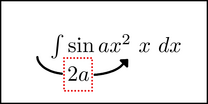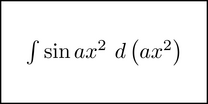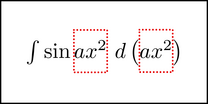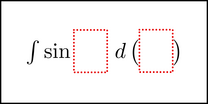Chunks and Chunking
Chunks and Chunking
There is a kind of mental device you can use called a chunk. We also speak of chunking, which is the action of creating a chunk. It's basically a tool for organizing your attention. You make a chunk by taking a group of symbols in the expression you visualize, and work with that group as a logical unit. Usually you would ``decorate'' it in some way, meaning that you would visualize that portion of the image a little differently. For example, you could visualize the chunk (group of symbols) as having a dotted line enclosing it, or visualize those symbols on a differently colored background from the rest of the expression.
When you chunk a group of symbols - and again, chunking is a mental action - you are basically saying that you intend to do something mathematically with them. Suppose you want to evaluate the integral ![]() , where a is a constant. To do it mentally, you would visualize the expression:
, where a is a constant. To do it mentally, you would visualize the expression:

(In this book, images you visualize internally are shown in a box like this.) Looking at it, you notice that the derivative of ![]() is
is ![]() . So one of the next steps is to determine if that derivative is part of the integrand, and if so, to group the differential
. So one of the next steps is to determine if that derivative is part of the integrand, and if so, to group the differential ![]() together. To manage this mentally, you would chunk the 2a on the left:
together. To manage this mentally, you would chunk the 2a on the left:

(We denote a chunk by putting a dotted box around it. You can visualize it this way yourself internally. As stated above, though, there are other valid ways to do it. You don't need to visualize it exactly as shown in the figure, if you find a way that seems to work better for you.)
Now that you have the chunk, you can move it to a better location in the expression:


What you see in your mind's eye is the 2a chunk actually moving from the spot on the left, sliding into place just before the ![]() (and scooting the
(and scooting the ![]() to the side in the process). Now, when you were first learning to do calculus, you would have written a line that looks like
to the side in the process). Now, when you were first learning to do calculus, you would have written a line that looks like
and then, underneath it, written
Moving the chunk mentally accomplishes the same thing... which is, of course, the whole point.
When integrating expressions, we sometimes use variable substitution to manage the complexity. Let ![]() and
and ![]() ; the integral then becomes the simpler expression
; the integral then becomes the simpler expression ![]() . Something similar can be done when evaluating the expression mentally, using chunks. The first step is to decide on the variable change - in this case,
. Something similar can be done when evaluating the expression mentally, using chunks. The first step is to decide on the variable change - in this case, ![]() . In the expression, chunk the set of symbols that will be replaced by the new variable:
. In the expression, chunk the set of symbols that will be replaced by the new variable:

Then visualize the chunked part being replaced with a new chunk, containing just the variable:

Swapping chunks like this is called chunk substitution. To complete the process, we must also replace the differential. Chunk the symbols corresponding to that,

then substitute the chunk.

At this point it's simple to evaluate the expression and change back to the original variable:


(C is the constant of integration, of course.)
There are many other things that can be done with chunks, such as cloning or copying them, moving them within the expression in different ways, creating several chunks in one expression (decorated differently so as to distinguish them), and more. It's a great organizational tool for doing higher mental math.
The best thing about chunks, though, is that as you use them, they train you to not need them. Chunks are to math much like training wheels are to riding a bike. As you do things with chunks many times, gaining confidence and experience, you will learn to do the kinds of mathematical transformations they produce more intuitively, without having to explicitly use chunks.
Let's look again at our example of the last section, ![]() . Jump to the step where we have rearranged the symbols, and are now ready to do the variable substitution. You are visualizing something like this:
. Jump to the step where we have rearranged the symbols, and are now ready to do the variable substitution. You are visualizing something like this:

We have already chunked the argument of the sine function here. This time, instead of doing a variable substitution, we will just work with chunks. Since ![]() and
and ![]() , you can also write
, you can also write ![]() as
as ![]() . Visualizing the expression to reflect this, it looks like
. Visualizing the expression to reflect this, it looks like

(Writing differentials like this is common in advanced math texts, by the way.) You can then chunk both occurrences of ![]() :
:

Now, if you wanted to, you could do chunk substitution with both, replacing ![]() with u. But you don't have to here. Variable substitution is a simplification, which you introduce to make the expression more manageable. When you chunk like this, though, you have already done something like that. In fact, at this point, you can visualize the expression like this:
with u. But you don't have to here. Variable substitution is a simplification, which you introduce to make the expression more manageable. When you chunk like this, though, you have already done something like that. In fact, at this point, you can visualize the expression like this:

See what we did? Semantically, this is just like visualizing ![]() . In case you are not familiar with the word, ``semantics'' refers to the meaning attached to symbols in a printed or visual form
. In case you are not familiar with the word, ``semantics'' refers to the meaning attached to symbols in a printed or visual form![]() .
. ![]() and the symbol u have the same mathematical meaning, so we say they are semantically equivalent. In this expression, the empty chunk represents
and the symbol u have the same mathematical meaning, so we say they are semantically equivalent. In this expression, the empty chunk represents ![]() , and has the same mathematical meaning too. Thus, the empty chunk is semantically the same as the expression
, and has the same mathematical meaning too. Thus, the empty chunk is semantically the same as the expression ![]() .
.
Incidentally, what we are doing above is a special kind of windowing. We are visualising only that part of the expression which we need to at this time. We really don't need to visualize the ![]() , so we don't. We know the empty chunk represents it.
, so we don't. We know the empty chunk represents it.
When you integrate, you can visualize this:

Even though you have transformed the expression, you are still windowing, because you are still excluding the ![]() from the image. At this point, you can recall the chunk's contents.
from the image. At this point, you can recall the chunk's contents.

The empty chunk is not quite the same thing as a regular chunk; it is a slightly different animal, acting in some respects like a placeholder. Remember, chunks are basically a device to help you organize and direct your attention. Most people think of attention as just concentrating on one thing or another. Attention also has a more subtle meaning, that includes the patterns and habits of exactly how you are directing that concentration. Using chunks trains you to use your attention in certain precise ways - ways that happen to be used by good mathematicians, engineers, and hard scientists.
Again, chunks are like training wheels on a bike. When you first get on a bike, you might need the training wheels in order to ride at all. They're great; you can ride really fast on this bike because of them. As you ride more, your skill and awareness grow, and you rely on the training wheels less and less. When you get good enough to do really fancy things, you might even find that they get in the way, so you don't use them. If you ever need them again in the future, though, they are always available.
The abilities you have between your ears are more expressive than can be put into words. What is written in these pages is meant to point you in the right direction, so that you can discover the rest for yourself as you do it.
Footnotes
- ... form
![[*]](/usr/share/latex2html/icons/footnote.png)
- The word ``semantics'' actually has a broader definition than this. For our purposes, the definition we use is fine.